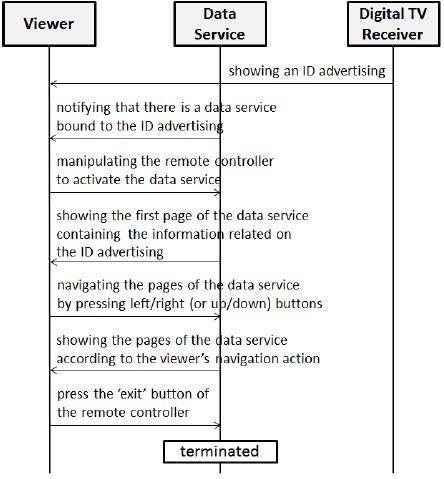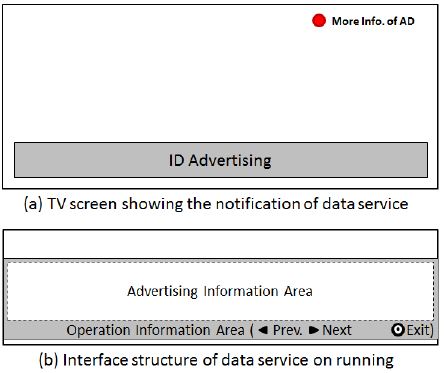
Design of Digital Broadcasting Data Service showing Supplementary Information of each Type of ID Advertisement
Copyright ⓒ 2018 The Digital Contents Society
This is an Open Access article distributed under the terms of the Creative Commons Attribution Non-CommercialLicense(http://creativecommons.org/licenses/by-nc/3.0/) which permits unrestricted non-commercial use, distribution, and reproduction in any medium, provided the original work is properly cited.

Abstract
The advertisement market is an industry that is heavily influenced by media changes. As the digital broadcasting has settled, TV, a typical advertisement medium, has evolved from a passive content consuming medium into a platform for operating various data services as well as broadcasting programs. These changes mean that viewers are able to actively consume TV contents including advertisement, so the broadcasting industry needs to consider about the growth strategies that link the advertisement market with data services. This study designed a digital broadcasting data service that provides supplementary information of ID advertisement with short exposure time (less than 10 seconds) and insufficient space (less than 1/4 of TV screen). Specifically, we designed the user scenario and user interface of the data service, defined representative types of ID advertisement and the supplementary information for each type, developed a method, based on the international digital broadcasting standard DVB, for providing the supplementary information to the data service.
초록
광고시장은 매체의 변화에 크게 영향을 받는 산업이다. 대표적인 광고 매체인 TV는 디지털방송이 정착되면서 수동적인 콘텐츠 소비 매체에서 방송프로그램뿐만 아니라 다양한 데이터서비스들을 운영할 수 있는 플랫폼으로 발전하였다. 이런 변화는 시청자가 광고를 포함한 TV 콘텐츠를 능동적으로 소비할 수 있는 환경이 조성되었음을 의미하기 때문에 방송 산업은 광고 시장과 데이터서비스를 연계한 성장 전략을 고민할 필요가 있다. 본 연구는 10초 이내라는 짧은 광고 시간과 TV 화면의 1/4 미만이라는 부족한 공간의 문제를 갖고 있는 ID 광고의 부가정보를 제공하는 디지털방송 데이터서비스를 설계하였다. 구체적으로, 데이터서비스의 사용자 시나리오와 인터페이스를 설계하고, ID 광고의 유형과 유형별 부가정보를 정의하여 그 부가정보를 데이터서비스에 공급하는 국제 디지털방송 표준 DVB 기반의 방법을 개발하였다.
Keywords:
Broadcasting Advertisement, Data Service, Digital Broadcasting, ID Advertisement키워드:
방송광고, 데이터서비스, 디지털방송, ID 광고Ⅰ. Introduction
Although there are many definitions of the advertisement, according to the Korean advertising society [1], the advertisement can be defined as “a form of non-facing communication in which the advertiser uses the mass media to persuade or influence the audience.” In broadcasting industry, there are the broadcasting program distribution market and the advertisement market that deals with consumers' access rights to advertisements. The revenue of the advertisement market enables viewers to use high quality broadcasting contents free of charge or at a very low cost.
The advertisement market is a field that is highly influenced by the emergence of new media or the technological development of media. According to the Hyundai Economic Research Institute, in the case of newspapers, the share of advertising spending decreased from 44.3% in 1991 to 23% in 2009 and is expected to decrease to 13% in 2020. In contrast, in the case of cable TV, it starts at 1% in 1995, grew to 19% in 2009, and predicted to grow to 26.6% in 2020. New media such as IPTV are expected to grow to 6.2% by 2020 [2].
With the establishment of digital broadcasting technology, TV has evolved into a platform that can run various data services from the media that only transmitted broadcasting programs. This has caused a concern that the occupancy of the viewer's time is dispersed by the opportunities of utilizing data services other than the broadcasting programs, which will adversely affect the broadcasting program distribution market and TV advertisement market. However, this change can be used as a new leap forward for the broadcasting industry with the growth strategies that link the possibility of data services to the TV advertisement market.
This study designed a data service that provides viewers with supplementary information related to ID advertisement, which is one of the subtitle advertisement types. ID advertisement exposes an advertising image at the bottom of the TV screen when broadcasting station name is being broadcast for 10 seconds (See Figure 1). ID advertisement is advantageous in that it is inexpensive compared to a general broadcasting program advertisement, but since it has a short exposure time of less than 10 seconds and an insufficient space of less than 1/4 of the TV screen in size, there is a weakness that ID advertisement can not contain enough information advertiser want to show. This paper covers the studies on designing the usage scenario and user-interface of the data service, defining the supplementary information for each representative types of ID advertisement, and devising a method for supplying the information to the data service based on the DVB (Digital Video Broadcasting) [3] SI (Service Information) protocol [4].
This study is meaningful in that it shows the possibility of growth of broadcasting industry through combination of the existing advertisement and the data service.
Ⅱ. Industry Trends and Technologies
2-1 TV Advertisement Industry Trends
One of the biggest advantages of TV advertising is that it can deliver creative advertising messages using various aspects of visual and auditory senses. With the advantage, advertisers can deliver advertising messages without damaging the image of high-end products, and can keep consumers' good feelings about the brand naturally [5].
According to the Korea Online Advertising Association in 2016, TV advertisement was the most effective medium in terms of ‘reliability’, ‘interest’, ‘commitment’, and ‘purchase decision’ among the evaluation criteria of the advertisement. However, as the consuming pattern of purchasing products after analyzing the detailed product information spread, TV advertisements are lagging behind PC and mobile advertisement in terms of ‘immediate response’ and ‘sales linkage’ [6]. As a result, in 2016, the broadcasting advertisement market decreased 7.4% year-on-year to 4,132.5 billion won. In particular, terrestrial TV sales fell 14% year-on-year to 1.662 trillion won, the largest drop in broadcast advertisement market. Although terrestrial TV sales have shifted to an increasing trend in 2017, it was only a mere 0.2% growth from 2016 [7]. This situation should be urgently addressed in the broadcasting industry where advertisement revenue is an important portion of sales.
Table 1 summarizes the types of TV advertisement. ID advertisement is included in the category of the subtitle advertisement along with 'Soon' advertisement, which is exposed at the bottom of the TV screen when transmitting a video notifying the next broadcasting program. Since the form of Soon advertisement is the same as ID advertisement, this study can be applied to Soon advertisement.
2-2 Data Service
With the development of digital technology, it has become possible to transmit digital data in addition to A/V signals in broadcasting signals, resulting in data services that run applications on the TV platform. In the early days, data services started from simple games and the information-providing services such as weather information, and various services such as T-government, T-commerce and T-karaoke were developed as the performance of digital broadcasting receiver developed [8].
In order to activate the data service, several researches have been performed on improving the convenience of data service manipulation using the motion and speech recognition technologies [9,10,11], and on how data services can make meaningful use of broadcasting program contents to connect viewers' interest in broadcasting programs to data services [12,13,14]. Still, however, there are few notable data services other than EPG (Electronic Program Guide) and VOD (Video On Demand), and it is continuously required to develop ‘killer applications’ of the data service.
Data services can be classified into ‘Independent’ and ‘Dependent.’ An independent service is running on a virtual channel, which has no broadcasting program, and a dependent service is running on a channel with a broadcasting program. Data services also can be classified into ‘Bound’ and ‘Unbound.’ A bound service, which can be executed only on a specific channel, automatically terminates when the channel changes, and an unbound service does not terminate by the channel change [15,16].
Ⅲ. Overview of Data Service
3-1 User Scenario
The data service is activated when the related ID advertisement is broadcast and displays a notification on the TV screen that the ID advertisement has a data service. A common way of indicating the presence of a data service is to show a message that the data service can be run by pressing a particular color button on the remote controller. We designed to use the red button on the remote controller to run the data service.
When a viewer presses the red button on the remote controller within the ID advertisement time (usually less than 10 seconds), the initial page of the data service is displayed. The pages of the data service contain the supplementary information of the ID advertisement, which is designed in consultation with the advertiser. As the data service can have several pages according to the amount of the information, a viewer can circulate the pages through the left/right or up/down buttons of the remote controller. The data service can be terminated via the exit button of the remote controller. It should be noted that the data service is not automatically terminated even after the ID advertisement time limit has passed unless the viewer intentionally ends it. The reason for designing as like is that unintentional termination negatively affects the user experience on the data service.
Figure 2 shows the basic usage scenario of the data service.
3-2 User Interface
The user interface of a data service is constrained in designing by the factors that the main purpose of the viewers is to watch the broadcasting programs and the remote controller is inconvenient to operate the data services. According to [17], it is recommended that the area occupied by a data service does not exceed 1/3 of the TV screen, the depth of the user interface is no more than 3 levels, and the data service can be terminated at any time by a single operation of the remote controller.
Since the area of ID advertisement does not exceed 1/4 of the TV screen, if the data service is designed to be 1/3 of the TV screen in size, the data service covers naturally the image of ID advertisement. If the data service is terminated before the ID advertisement exposure time expires, the image of ID advertisement will be exposed again. For this reason, all pages of the data service were designed to be 1/3 of the TV screen in size.
When ID advertisement is being exposed, a notice indicating the existence of the associated data service and how to execute it is shown by a red button icon and a simple phrase ‘More Info. of AD.’ When a viewer presses the red button on the remote controller, the initial page of the data service is displayed. All pages of the data service are divided into the ‘Advertising Information’ area showing the supplementary information of the ID advertisement, and the ‘Operation Information’ area showing how to navigate the pages of the data service and terminate it (See Figure 3). There is no pop-up window asking for confirmation of termination because the data service should be terminated by single operation of the remote controller.
Ⅳ. Information Type Definition
Since ID advertisement has the strict time constraint of up to 10 seconds and there is no guarantee that viewers will spend a lot of time on the data service, the data service must quickly show key information according what to advertise. Therefore, this study divided the types of ID advertisement into 'Product Promotion’, 'Company Promotion', 'Event Promotion', and defined key supplementary information for each type so that the data service can efficiently process the data.
● Product Promotion Type’s Supplementary Information
The advertising objects of Product Promotion type include a variety of goods ranging from home appliances to travel products of travel agencies. In this study, the supplementary information of Product Promotion type is defined as a set of product name, company name, price, promotional sentence, and URL address for more detailed information.
<Info. of Product Promotion Type>::= <Product Name>+<Company Name>+<Price>+<Promotional Sentence>+<URL> <Product Name>::= String <Company Name>::= String <Price>::= String // includes the currency unit <Promotional Sentence>::= String <URL>::= String // URL address of the internet page. |
● Company Promotion Type’s Supplementary Information
The advertising objects of Company Promotion type may be corporations, universities, government agencies, and so on. The advertising purpose of this type is generally to improve the brand image of the advertising objects. The supplementary information of this type is defined as a set of company name, promotional sentence, location, telephone number, and URL.
<Info. of Company Promotion Type>::= <Company Name>+<Promotional Sentence>+<Location>+<TEL>+<URL> <Company Name>::= String <Promotional Sentence>::= String <Location>::= String <TEL>::= String // Telephone number <URL>::= String |
● Event Promotion Type’s Supplementary Information
The advertising objects of Event Promotion type include various local festivals, apartment sales announcements, and performance events such as the singers and magicians shows. The location and duration of an event, the organizer and cast, and the contact information are important. The supplementary information of Event Promotion type is defined as a set of event title, promotional sentence, location, duration, cast, organizer, contact point, and URL.
<Info. of Event Promotion Type>::= <Event Title>+<Promotional Sentence>+<Location>+<Duration>+<Cast>+<Organizer>+<Contact Point>+<URL> <Event Title>::= String <Promotional Sentence>::= String <Location>::= String <Duration>::= <Opening Time>+<Closing Time> <Opening Time>::= String <Closeing Time>::= String <Cast>::= (String)* <Organizer>::= String <Contact Point>::= String <URL>::= String |
Ⅴ. Method for Transmitting Information
The supplementary information of ID advertisement is supplied to the data service using the SI tables defined in DVB, which is an international standard for digital broadcasting. SI is a protocol for transmitting the operational information necessary for the digital broadcasting receiver to construct channels and EPG contents. SI classifies the operational information according to the characteristics of the information and defines various tables for transmitting the classified information. For example, SI defines a table called ‘Service Information Table (SIT)’ to transmit the service related information such as service name, service provider, and encryption information. For reference, the service described above is a concept, defined in MPEG, similar to the channel that we generally know.
SI tables can contain the structure called 'Descriptor' that can include information defined arbitrarily by a broadcasting station or service provider. For example, a service provider may construct a descriptor called Weekly_Event_Rank_Descriptor ( ) to store weekly popularity ranking information of the events, and include it in SIT to transmit to the digital broadcasting receiver. For reference, the event is a concept, defined in MPEG, similar to the broadcasting program that we generally know.
In this study, considering the short exposure time of ID advertisement, we designed a set of descriptors for containing the supplementary information of each type of ID advertisement, and decided to use EIT-P as the table for transmitting the descriptors to the data service. Event Information Table (EIT) is an SI table for transmitting the information related to the events such as the event names, broadcasting schedules, and parental rating information. EIT-Present (EIT-P) is a type of EIT that transmits the information of the event currently broadcasting. Since the EIT-P is repeatedly transmitted in a short period (usually within 500ms), it is advantageous to transmit the information that is time-sensitively interlinked with an event.
<Table 2> to <Table 4> show respectively the descriptors for containing the supplementary information of Product Promotion type, Company Promotion type, and Event Promotion type of ID advertisement.
Ⅵ. Conclusion
With the establishment of digital broadcasting technology, TV, a representative passive media, has been developed into a smart media that can run various data services, and the viewer’s behavior is changed from a passive attitude to an attitude of actively consuming the media. These phenomena lead to change the form of TV advertisement because the advertisement market is highly influenced by the change of the media. In other words, as the TV evolves into a platform for operating data services and the media consuming behavior of viewers becomes active, the broadcasting industry needs to consider new growth strategies that link the possibility of data services with the advertisement market.
In the context, this study has designed a data service that provides the supplementary information of ID advertisement, which is hard to be shown by the short exposure time and the lack of space. The study includes the design of the usage scenario and user interface of the data services, and the development of a method for transmitting the supplementary information of ID advertisement to the data service based on the international digital broadcasting standard DVB. Considering that the exposure time of ID advertisement is shorter than 10 seconds, we recommend to operate the data service as an ‘Embedded’ service. Embedded service refers to a data service of which the execution code and necessary data are downloaded in a nonvolatile memory when a digital broadcasting receiver is booted. By operating in this way, it is possible to activate the data service immediately when ID advertisement starts.
Although this study was conducted for ID advertisement, it can be applied to all types of the subtitle advertisement including the soon advertisement. As the subtitle advertisement is lower in cost than the program advertisement, it is attracting attention as an advertisement type suitable for the ‘long-tail’ strategy of TV advertisement.
Acknowledgments
This research is based on the support of 『2018 Woosong University Academic Research Funding』
References
- Korea Advertising Society Home Page: http://www.koads.or.kr
- “Broadcast Industry Outlook and Challenges in Omni Media”, Hyundai Research Institute, No. 424, Nov), (2011.
- “ETSI EN 301 192 v1.4.2: DVB specification for data broadcasting”, ETSI, DVB, (2008).
- “Digital Video Broadcasting (DVB): Specification for Service Information (SI) in DVB systems,”, ETSI, DVB, (2004).
- Yongho Bae, The case study on the emotional marketing of enterprise : focused on broadcasting advertising, MS Thesis, Kongju University, (2013).
- Yoon-Jeong Na, and et. al. , “Research and Analysis on Online Advertising Industry Trend”, research and analysis, Korea Internet & Security Agency, Dec), (2016.
- Won-gi Park, “A Study on Ad Expenditure and Long-term Forecasting”, KOBACO, Dec), (2016.
- “Current Status and Implications of Data Broadcasting Service Market”, DIGIECO, (2008).
- M. Sohn, S. Lee, B. Kim, J. Lee, C. Park, “Implementation of Interactive TV Control System(ITCS) using hand gesture recognition”, Proceedings on KIISE Conference, (2010).
- W. Kim, H. Jeon, S. Park, “Multimodal interface for Korean inputs using speech and keypad”, Proceedings on Korean HCI Conference, (2007).
- J. Park, H. Chung, E. Chung, B. Kang, K. Park, Y. Oh, Y. Lee, “Implementation of the Speech Recognition Service System for Smart TV”, Proceedings on IEIE, (2013).
- Moon-Ryul Jung, Cha-won Lee, Yoon-Seok Nam, Gwang-Soon Lee, Kwang-Yong Kim, "Protocol for Synchronized Application in Terrestrial DMB Data Broadcasting and its Implementation", Proceedings on the Korean Society of Broadcast Engineers, (2005).
- Kwangil Ko, “A TV Viewer's Modality-based Searching System Designed for Running on TV Set”, The Journal of Digital Contents Society, 11(3), (2010).
- K. I. Ko, “A Method for Semantically binding a Data Service to a Broadcasting Program”, The Journal of Digital Contents Society, 13(4), (2012).
- “ETSI EN 301 192 v1.4.2: DVB specification for data broadcasting”, ETSI, DVB, (2008).
- “ETSI TR 101 202 v1.2.1: Implementation guidelines for Data Broadcasting”, ETSI, DVB, (2003).
- Kwangil Ko, “A Data Broadcasting Service Design Guideline based on the Survey on Viewer’s Modality of Using Data Broadcasting Services”, The Journal of Korea Game Society, 12(6), (2012).

고광일(Kwangil KO)
1995년 : 포항공과대학교 전자계산학과 (학사, 석사)
1999년 : 포항공과대학교 컴퓨터공학과 (공학박사)
1999년~2010년 8월: (주)알티캐스트 사업품질관리본부 본부장 및 서비스개발사업팀 팀장
2010년 9월~현재: 우송대학교 테크노미디어융합학부 영상콘텐츠전공 교수
※관심분야: 디지털방송 소프트웨어, 스마트TV방송UI/UX, 소프트웨어공학, 요구분석공학, N-스크린 서비스, 소프트웨어 교육



